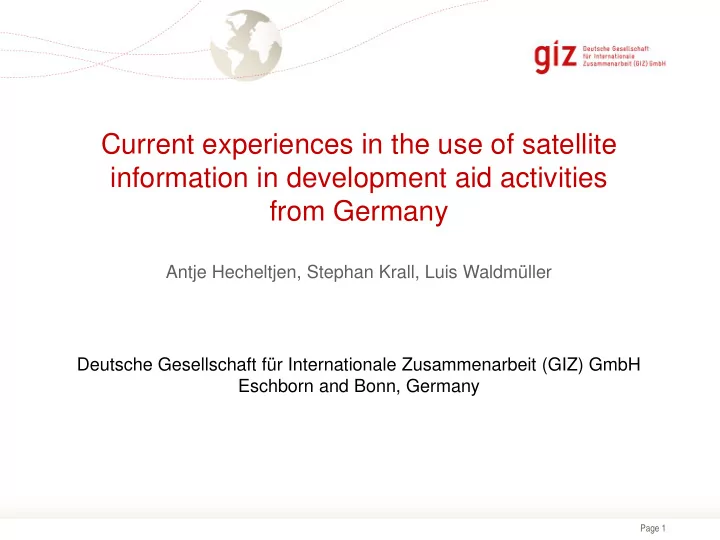

Current experiences in the use of satellite information in development aid activities from Germany Antje Hecheltjen, Stephan Krall, Luis Waldmüller Deutsche Gesellschaft für Internationale Zusammenarbeit (GIZ) GmbH Eschborn and Bonn, Germany Page 1
Earth Observation at GIZ is embedded into global and national agendas Project level: Survey on the use of Global level: Environmental EO in GIZ projects and development agendas focussing increasingly on availability of and access to data. National level: Digital agenda of German government including big and open data for development. Institutional strategic level: GIZ and DLR executive boards signed cooperation agreement. Institutional operational level: Recently founded Forum on Earth Observation at GIZ. Page 2
Field of application and information products Forest ( i. e. REDD+ Projects) Assessment of forest areas (forest type mapping) Monitoring of deforestation processes (FLC-Change maps) Calculation of carbon storage Recording and prediction of pest infestation (risk maps) Land and pasture management Monitoring of crops (crop mapping, post-disaster maps, harvest forecast models) Planning of cultivation areas (suitability maps, farmland fragmentation) Land Governance Land use planning (LULC-maps) Assessement of land degradation (erosion maps) Cadastre map for the registration of land ownership and land use rights Water Water management (mapping of watersheds/river catchment areas) Flood control (flood risk mapping/modelling) Biodiversity Habitat management (habitat mapping, habitat fragmentation) Page 3
Analysis and end users of the EO-data Governmental administration: local authorities (planning offices, land registry, cadatser offices), ministries (Environment, Agricultur, Forest…) Policy makers Partner organisations: Others: e. g. Reporting to the World Heritage Commission Reseach institutes Students or no Universities Private sector, i. e. retailer, insurances further use of National comitees data Public authorities Civil society, i. e. disaster relief organisations 10% Research institutes/ Universities 35% NROs, civil society External service 25% providers: GIZ-internal RS-provider Consulting- companies 30% GIZ-internal Page 4
Earth Observation in German international cooperation 1 2 3 4 5 6 7 8 9 10 Flood Suitability Proofing Maps 2, 3, 10 2, 3, 10 Disaster risk Fire mapping Monitoring 3, 4, 10 4, 10 Land Bush Degradation encroachment Neutrality 4, 8, 9 4 National Parks Irrigation 4 4, 6, 9 Page 5
Presentation title Invasive species in African drylands Using EO to map Parthenium hysterophorous spread and risk areas in African drylands for scaling out of crop productivity measures Landsat-based classification used as „training“ data for modelling areas of propagation • of invasive species based on MODIS-EVI time series. • User: Ministry of Livestock in Somaliland used risk maps to identify risk zones and plan measures. Source: Landmann et al., forthcoming
Land Degradation Neutrality (LDN): Example Namibia LDN baseline setting Baselines on land cover, land productivity, and soil organic carbon Additional country-specific indicator: bush encroachment LDN integration in existing planning process As a legally binding plan, the Integrated Land Use Planning (IRLUP) can be used to transfer the national LDN vision into local action Overall project aim: Enable the planning committee to include LDN into the IRLUP Usefulness of data: Bush encroachment was integrated, but assessments of other indicators were only partially taken up (LUC, productivity) or not at all (SOC). Page 7
Land Degradation Neutrality (LDN): Example Namibia Link to the data portal: https://csi.maps.arcgis.com/apps/MapSeries/index.html?appid=b00fa0610c3741bd9ca3318a5a557535 Page 8
Monitoring and Planning of National Parks, Cameroon/Chad Automatic Counting of Large Mammals from Very High Resolution Panchromatic Satellite Imagery Analysis of satellite images: Current land use and land http://www.mdpi.com/2072-4292/9/9/878 use trends in BSB Yamoussa ( Mission report 2017) Page 9
Monitoring of irrigation areas and water use for agriculture (Souss-Massa, Morocco) Development of land use change maps (2002-2013) Statistical evaluation of maps for community level Page 10
Disaster Risk Mapping in Badakhshan, Afghanistan Hazards : Avalanches Landslides Floods Avalanch risk map Source: GIZ 2011 Accuracy of ASTER DEM limited the accuracy of the results (2011). Page 11
Flood Proofing in Vietnam, Mekong Delta Example: City center of Long Xuyen, An Gian Province, Vietnam Digital Surface Model (DSM)-data of WorldDEM (Tandem-X) Generation of Digital Terrain model (DTM) for flood modelling ALOS-Palsar interferograms to quantify ground subsidence prediction of estimated elevation Use: Estimation of future flood hazard and flood events Page 12
Suitability Map Method: Integrating Disaster Risk Management (DRM) and Climate Change Adaptation (CCA) (Philippines, Vietnam) Multi Hazard [%/year] Source: GIZ 2015 • Problem: Hazard maps do not provide the likelihood or probability of the occurrence of a certain type of hazard in a certain area • Users: Local government units of Leyte. land use planners are able to quickly assess the risks for normal residential buildings anywhere in Leyte as well as to assess risks for future projects and structures. Application to improve climate change adaptation. • Now being piloted in Vietnam. Page 13
Prevention, Control and Monitoring of Fires in the Brazilian Cerrado • Data: Landsat-8 and Sentinel-2 • Fuel load mapping and SMA as an effective tool in support of Integrated Fire Management (IFM). Useful to identify • areas with high fire risk, assess the fuel load variation, assess the remaining fuel load after a fire, evaluate fire management activities and to Fuel load mapping using Spectral Mixture Analysis (SMA) better understand fire behavior.
Points for Discussion • Do not only export solutions but build capacities • Too much information is slowing decision processes down. Need standardized information products (e.g. SOC, soil moisture, hazard maps…) • End-users of data need to be involved from the beginning to create ownership and to increase the potential uptake. Training end-users in using the data. • Need to identify existing processes to dock on to, e.g. land use planning processes. Timing of information provision needs to be aligned to timing of planning processes. • Monitoring SDGs should not be an aim in itself but it should support planning and implementation to reach the goals and targets. • Break up silos; make information available to all relevant ministries and agencies (NSDI? – coordination needed) Page 15
Thank you very much for your attention! Page 16
Recommend
More recommend